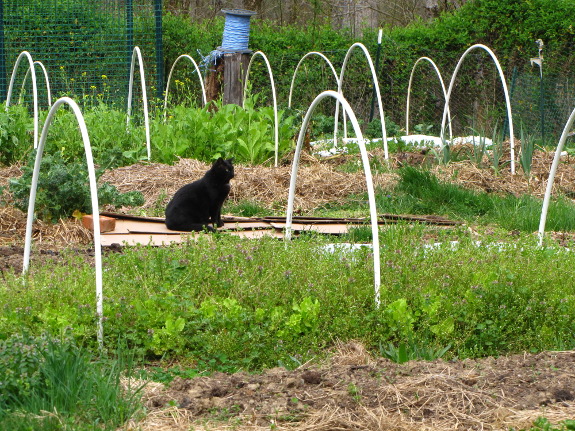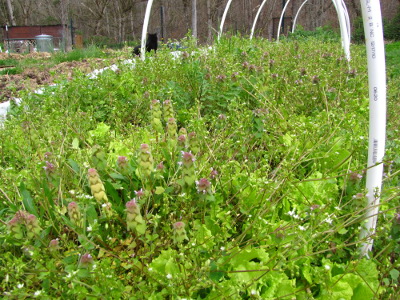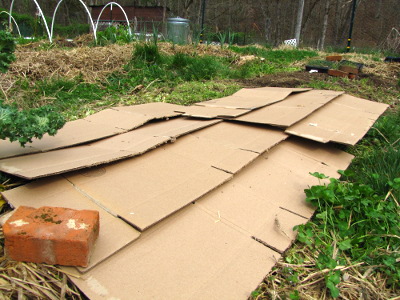
Spring weeding quick fix

 The
mule garden appears so idyllic...until you look closer and notice that
several of the beds have grown up in a mass of chickweed and
purple dead nettle.
My greens overwintered well enough under the quick
hoops to outcompete
most weeds, but the lettuce mostly died and left plenty of warm, bare
ground into which invaders could sprout.
The
mule garden appears so idyllic...until you look closer and notice that
several of the beds have grown up in a mass of chickweed and
purple dead nettle.
My greens overwintered well enough under the quick
hoops to outcompete
most weeds, but the lettuce mostly died and left plenty of warm, bare
ground into which invaders could sprout.
If I'd been smart, I
would have taken down the hoops once the lettuce died and let the cold
slow down the weeds, then ripped the chickweed out and mulched the bare
soil. But I've spent all month working on the perennials, only
giving the vegetable garden enough care to get early spring beds
planted. Luckily, there's a way to remediate the weedy ground
without tilling --- a kill
mulch.
 First,
I ripped off the worst of the above-ground weeds and laid down a thin
layer of cardboard. In my perennial patches, I've been using two
thicknesses of corrugated cardboard since I have hefty weeds like
wingstem trying to poke up, but one layer of cardboard is plenty as a
weed barrier in a mostly-well-maintained vegetable garden. I
tossed some straw on top of the cardboard and proclaimed it done.
First,
I ripped off the worst of the above-ground weeds and laid down a thin
layer of cardboard. In my perennial patches, I've been using two
thicknesses of corrugated cardboard since I have hefty weeds like
wingstem trying to poke up, but one layer of cardboard is plenty as a
weed barrier in a mostly-well-maintained vegetable garden. I
tossed some straw on top of the cardboard and proclaimed it done.
Meanwhile, other bare
beds that won't be planted until May or June are getting a very
experimental seeding of buckwheat. The cover crop isn't
frost hardy, but I've seen some leftover seeds germinating in the
garden already, so I thought I'd give it a shot. I'll let you
know if we get a frost-free month to provide optimal biomass
accumulation, or whether I threw my fifty cents and five minutes of time down the drain.
Want more in-depth information? Browse through our books.
Or explore more posts by date or by subject.
About us: Anna Hess and Mark Hamilton spent over a decade living self-sufficiently in the mountains of Virginia before moving north to start over from scratch in the foothills of Ohio. They've experimented with permaculture, no-till gardening, trailersteading, home-based microbusinesses and much more, writing about their adventures in both blogs and books.
Want to be notified when new comments are posted on this page? Click on the RSS button after you add a comment to subscribe to the comment feed, or simply check the box beside "email replies to me" while writing your comment.
